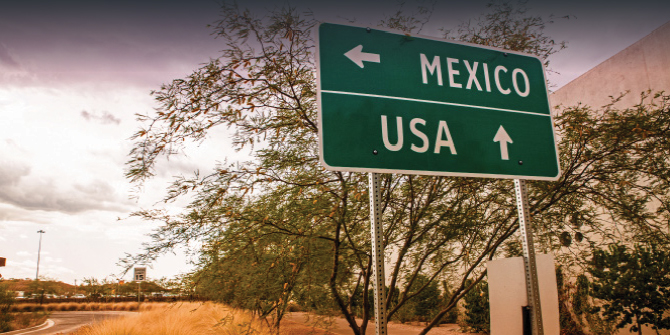
Beyond the Border
The perilous plight of Mexicans in the U.S.
By Mayté Rodríguez Cedillo and Karin Leperi
The United States has long prided itself on the economic vitality, dynamic diversity, and creative ingenuity of its people – people who have immigrated from all over the world and continue to contribute to the national creative genius of democracy. After all, here in America we are all descendants of immigrants.
Unfortunately, our shared border to the south with Mexico has become both a source of controversy and intense dogma, one with an uncontrolled complexity that defies simple solutions. Caught in the vice grip are over 11 million undocumented immigrants in the U.S. Their lives hang in limbo as they straddle chaotic legalities leaving them in a confounding lurch – one without status in a country they have called home for most their lives.
The common thread to this tangled web is the terrible disruption to lives on both sides of the border that a vacillating policy brings. It affects those attempting to come to the U.S. illegally and those already in the States as illegal aliens – a term that generally includes undocumented aliens and nonimmigrant visa overstayers.
Some have given birth to children while residing in the States illegally. Under the Fourteenth Amendment of the Constitution, these children become U.S. citizens: “All persons born or naturalized in the United States, and subject to the jurisdiction thereof, are citizens of the United States.” In other words, birthright citizenship is a guaranteed constitutional right.
Sometimes referred to as anchor babies, some think that the undocumented parents leverage their children’s citizenship so that they may become legal. However, under the young Trump Administration, there is no grace granted to undocumented parents – they are being deported with young children left behind. The question becomes how many are involved? According to Pew Research Center, approximately 295,000 babies were born in 2013 to undocumented immigrants, or 8% of the 3.9 million births in the United States that year.
Unfortunately, the outcome is that humanity is muffled, strained by the weight of motivated reasoning and fear-based prejudices. Instead of bridging boundaries between the U.S. and Mexico, we erect walls that divide and separate. Whether the barrier is physical from the erection of an actual wall or virtual through overt discrimination and marginalization of a people looking for hope, the deleterious impact on human lives is undeniable.
The Stereotype
According to ProCon.org, a group that tracks data on controversial issues, it’s not that simple. What they do know is that the issue of illegal immigrants continues to polarize Americans, resulting in a flurry of misperceptions, a circulation of falsehoods rather than facts, and a general marginalization of illegal immigrants and the associated human costs.
Nationalistic politicians and predisposed citizens continue to stereotype Mexican immigrants as basically illegals who steal jobs, increase crime, burden public welfare, and refuse to assimilate. They see illegal aliens as criminals who have broken the law and should not be rewarded with a path to citizenship ahead of those who legally immigrate.
Others of a more liberal persuasion point out that illegal aliens perform work that Americans don’t want, like dishwashing, yard work, factory, and agricultural migrant work. They also bring in additional tax revenue along with family values and a hard work ethic.
Even Mexicans who live on the other side of the border in Mexico are generally resentful of those who illegally benefit from border crossings without documents. Many who have chosen the legal path by applying for green cards, asylum, and/or U.S. citizenship, are resentful of those who circumvent the line.
David Benkof, Senior Policy Analyst at The Daily Caller, stated in an October 13, 2015, article: “Illegal immigrants, in their arrogance, have shown they believe our immigration rules do not apply to them. They have jumped the line – basically stealing a chance at a better life from millions of people around the world who would like to live in America.”
The Reality
Based on demographic data compiled by US Department of Homeland Security, the US Immigration and Naturalization Service, the Pew Hispanic Research Center, and ProCon.org, a group that tracks data on controversial issues, they state:
“As of 2012, the population of immigrants in the United States illegally is estimated to be approximately 11.43 million, roughly 3.7% of the entire US population. 59% of the immigrants in the country illegally are from Mexico, and 25% of all immigrants in the country illegally reside in California. 53% of the immigrants in the United States illegally are male. In 2008, approximately 31% of workers in the roofing industry and 27% of maids/housekeepers were immigrants living in the country illegally.”
The Human Factor
With all the heated discussion, hatred, and fear spewing out over what to do with 11 million plus undocumented workers in America, few discussions focus on the human factor. What are the financial, emotional, and social costs to individuals who risk all to seek a better life? What is life like when one becomes incognito and disdainfully discarded to the edge? What is the fate of those left south of the border?
Where are the stories that speak to humanity, that open our eyes and pulse our hearts when we encounter strewn artifacts along the border…abandoned back packs, empty water bottles, and twisted rosaries that once belonged to breathing, but downtrodden humans? These are the stories that media should be telling.
Ray Germano, director of The Other Side of Immigration, research scholar at the New York University School of Law, and an adjunct professor with the New York University Program in International Relations, has interviewed 700 Mexican families to see what the common motivators are that risk human life. The result is a 55-minute documentary that delves into issues why people leave their Mexican villages for the uncertainty of the U.S. and how it impacts family members and relatives on both sides of the border.
The overwhelming response was to improve their lives and the lives of their children. He said, “The reason for their migration to the US, is universally for the betterment of one’s own life, and the possibility of helping out the rest of one’s family. This fact alone is hardly ever touched on in the main stream media in the US. Mexicans move to the US in order to make more money, and use this newfound wealth to help their family back home.”
The American Library Association Notable Video has been presented at hundreds of film festivals, high schools, government, and institutions of higher learning. Germano’s hope is that, “By understanding ‘the other side’ of the story, we’ll begin to think about new and more creative ways that the U.S. and Mexican governments can work together to develop new solutions.”
Meanwhile, Crystal Bridges Museum in Bentonville, Arkansas, recently wrapped up a temporary exhibit on illegal immigration. Titled “Border Cantos” the artistic sight and sound collaboration by American photographer Richard Misrach and Mexican composer Guillermo Galindo were designed to harness “the power of art to explore, share, and humanize the complex issues surrounding the borderlands between the United States and Mexico.” In the process, the artists hope to shed light on immigration complexities while promoting dialogue to bridge boundaries.
The Wall
Germano remains surprised that the Mexican perspective continues to be ignored as politicians and statesmen develop policies to address immigration issues. “Building a wall without understanding the forces that trigger, drive, and perpetuate undocumented Mexican immigration is akin to trying to patch up a leaky dam without understanding anything about the river that it is meant to contain,” said Germano. “Engineers understand the importance of structure and learning from failure. Why don’t our policymakers?”
About a year earlier on February 8, 2016, Mexican president-elect Felipe Calderon stated his concerns during a visit to Ottawa while trying to seek Canadian opposition against the wall: “It is deplorable to go ahead with this decision of the wall at the border. The wall will not solve any problem.”
“Humanity made a huge mistake by building the Berlin Wall and I believe that today the United States is committing a grave error in building the wall on our border. It is much more useful to solve common problems and foster prosperity in both countries.”
On January 25th of this year, President Trump signed an Executive Order to increase border patrol forces and begin plans to build a border wall to the estimated tune of $21.6 billion dollars to the American taxpayer. (Estimate is from an internal Homeland Security report). During his campaign for presidency of the United States, Trump emphatically stated that the wall would be paid for by Mexico.
It’s not that simple. Until policy solutions address the root cause of the problem, the economic underpinnings of poverty and disparity of resources between the two countries will continue to be instigators as well as prime motivators for illegal immigration. The solution may very well be one of assisting our southern neighbor in becoming economically viable, while providing its citizens with the merits of a reformed democracy vice violent drug cartels.





